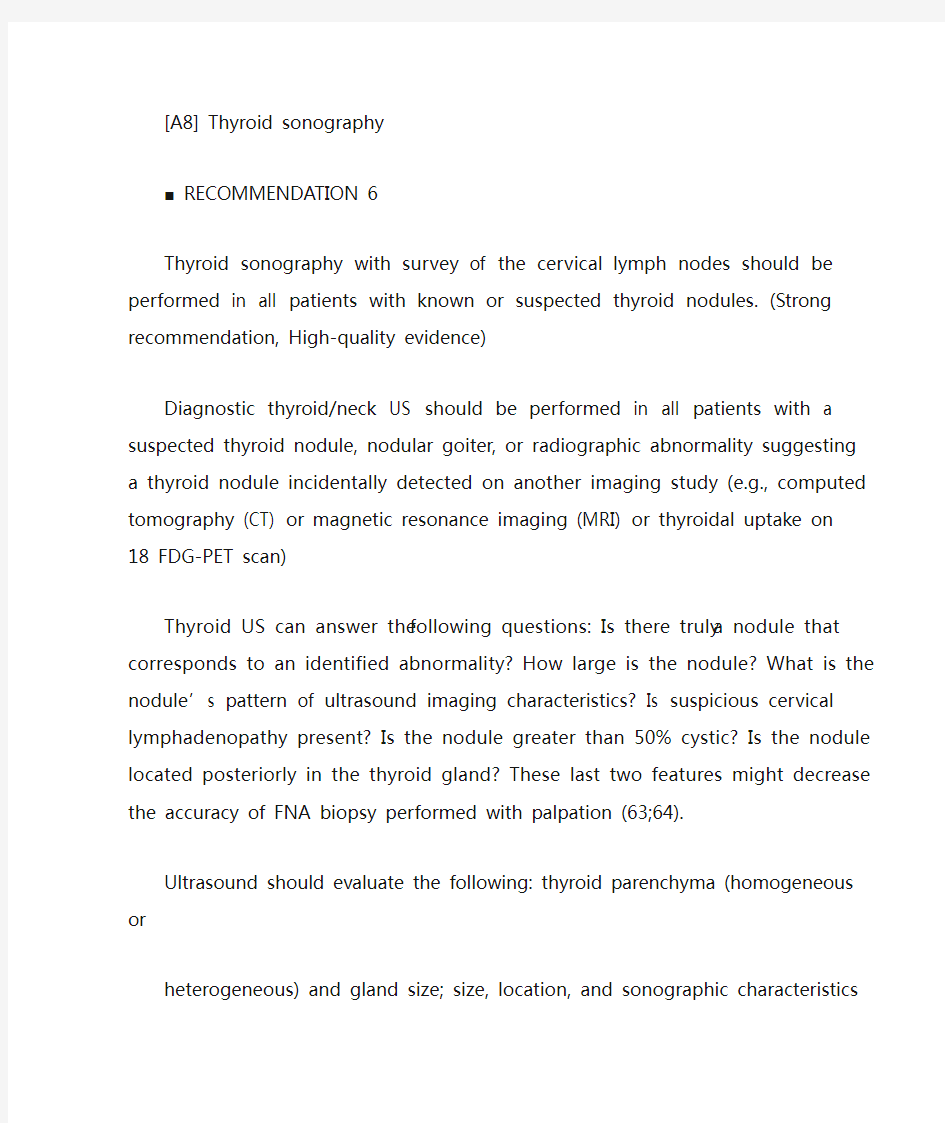
英文参考文献
- 格式:doc
- 大小:284.00 KB
- 文档页数:5


[A8] Thyroid sonography
■RECOMMENDATION 6
Thyroid sonography with survey of the cervical lymph nodes should be performed in all patients with known or suspected thyroid nodules. (Strong recommendation, High-quality evidence)
Diagnostic thyroid/neck US should be performed in all patients with a suspected thyroid nodule, nodular goiter, or radiographic abnormality suggesting a thyroid nodule incidentally detected on another imaging study (e.g., computed tomography (CT) or magnetic resonance imaging (MRI) or thyroidal uptake on 18 FDG-PET scan) Thyroid US can answer the following questions: Is there truly a nodule that corresponds to an identified abnormality? How large is the nodule? What is the nodule’s pattern of ultrasound imaging characteristics? Is suspicious cervical lymphadenopathy present? Is the nodule greater than 50% cystic? Is the nodule located posteriorly in the thyroid gland? These last two features might decrease the accuracy of FNA biopsy performed with palpation (63;64).
Ultrasound should evaluate the following: thyroid parenchyma (homogeneous or heterogeneous) and gland size; size, location, and sonographic characteristics of any nodule(s); the presence or absence of any suspicious cervical lymph nodes in the central or lateral compartments. The ultrasound report should convey nodule size (in 3 dimensions) and location (e.g. right upper lobe) and a description of the nodule’s sonographic features including: composition (solid, cystic proportion, or spongiform), echogenicity, margins, presence and type of calcifications, and shape if taller than
wide, and vascularity. The pattern of sonographic features associated with a nodule confers a risk of malignancy, and combined with nodule size, guides FNA decision-making (65;66) (see Recommendation 8).
In the subset of patients with low serum TSH levels who have undergone radionuclide thyroid scintigraphy suggesting nodularity, ultrasound should also be performed to evaluate both the presence of nodules concordant with the hyperfunctioning areas on the scan, which do not require FNA, as well as other nonfunctioning nodules that meet sonographic criteria for FNA.
■RECOMMENDATION 8
Thyroid nodule diagnostic FNA is recommended for (Figure 2, Table 6):
A) Nodules > 1cm in greatest dimension with high suspicion sonographic pattern (Strong recommendation, Moderate-quality evidence)
B) Nodules > 1 cm in greatest dimension with intermediate suspicion sonographic (Strong recommendation, Low-quality evidence)
C) Nodules > 1.5cm in greatest dimension with low suspicion sonographic pattern (Weak recommendation, Low-quality evidence)
Thyroid nodule diagnostic FNA may be considered for (Figure 2, Table 6):
D) Nodules > 2cm in greatest dimension with very low suspicion sonographic pattern (e.g. –spongiform). Observation without FNA is also a reasonable option (Weak recommendation, Moderate-quality evidence)
Thyroid nodule diagnostic FNA is not required for (Figure 2, Table 6):
E) Nodules that do not meet the above criteria. (Strong recommendation, Moderate-